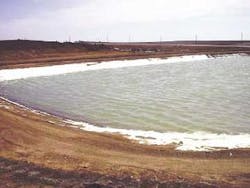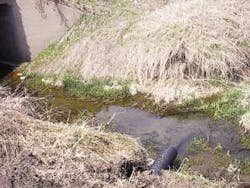Midwest Ethanol Producer Solves Wastewater Problems
By H. Scott Byram, Rebecca Lance Svatos and Timothy Ellis
An ethanol producer located on approximately 100 acres in rural Iowa started production in early 2002. The facility is operated by a farmer-owned cooperative whose members deliver a large volume of wet corn to an uncovered temporary storage facility at harvest, saving them handling and drying costs. The corn is processed by a dry milling process to produce ethanol.
The facility was designed to have no wastewater discharge. Reverse osmosis reject water and iron filter backwash water from treating groundwater for process use was permitted for discharge to a nearby stream along with non-contact cooling water. A lined 500,000-gallon surge pond was built for collecting and holding evaporator condensate and boiler blowdown before processing it back through the facility. However, wastewater problems began early.
Just three months into startup when the facility was at less than half its planned operating capacity, the surge pond was full and the facility had no permit to discharge its contents. In addition, stormwater runoff from its corn storage facility was found to require treatment prior to discharge. The facility obtained permission from the Iowa Department of Natural Resources (IDNR) for a one-time land application of the surge pond wastewater. In spite of efforts to reduce wastewater generation, the facility was unable to balance water use and wastewater generation and began looking for long-term solutions to its wastewater problems.
The first step was to characterize the wastewater. Laboratory analysis of wastewater in the surge pond indicated biochemical oxygen demand (BOD) levels of 5,900 - 9,200 milligrams per liter (mg/L). BOD levels of 600 - 1,200 mg/L were found to be typical for similar facilities operating at full capacity. A water balance for the facility was reevaluated, indicating wastewater flows were currently in the range of 19,000 – 36,000 gallons per day (gpd).
With the assistance of Stanley Consultants, the facility evaluated wastewater management alternatives. Because of the rural location, discharge to a publicly-owned treatment works (POTW) was not feasible. The closest community only has about 400 residents and could not handle the wastewater discharge. The nearest communities that might be able to accept the wastewater were at least 25 miles away.
Land application could be used on a permanent basis, but long-term arrangements with local farmers would need to be developed and a large storage tank constructed to hold wastewater during the winter months when land application was not feasible. An anaerobic treatment facility, used by other ethanol producers to pretreat wastewater prior to discharge to a POTW, would be difficult to operate and would not meet the low effluent limits anticipated for discharge to the nearby intermittent stream with little assimilative capacity.
Aerobic treatment lagoons appeared to be the best alternative. A lagoon system would be easy to operate and the facility had plenty of land for the lagoons. Stanley Consultants felt the lagoon discharge would meet the anticipated effluent limits. Both a controlled discharge lagoon system and an aerated lagoon system were evaluated.
A controlled discharge lagoon system consists of large shallow ponds which utilize natural aeration and biological activity to treat wastes. These systems need a long detention time to achieve the desired effluent quality and typically only discharge twice a year. The wastewater is stored and treated the remainder of the time. An aerated lagoon system is a smaller system which discharges continuously. Floating aerators mix air into the wastewater, increasing biological activity. The same level of wastewater treatment can be achieved in smaller lagoons than with a controlled discharge system.
Because an aerated lagoon system provides more flexibility for treating potentially higher future wastewater loads, an aerated lagoon system was selected to treat the wastewater.
The wide potential range of wastewater flows and concentrations made selection of design parameters difficult. Based on available information, a lagoon system was designed to treat an average flow of 27,000 gpd and an average BOD concentration of 6,000 mg/L. The design and construction permit application were submitted to IDNR for approval. IDNR had never permitted a lagoon system to treat wastewater with organic loadings this high before. IDNR officials were concerned that the wastewater would not be adequately treated and asked that laboratory treatability testing be conducted.
Stanley Consultants contracted with Iowa State University (ISU) to determine biodegradation rates for the wastewater. Because the facility was also planning to treat stormwater runoff from its corn storage facility, testing of the stormwater (with BOD levels as high as 3,000 mg/L) was included. Four separate samples were collected and submitted to ISU for testing.
Batch respirometric testing based on a respirometric technique developed by Ellis et. al. was conducted at three temperatures using biomass from two separate plants. The change in oxygen concentration in response to an injection of the sample was observed as a function of time. The response curve was normalized to ignore the rate of endogenous metabolism and was fit with biodegradation (Monod) kinetic parameters. The first-order, maximum specific substrate utilization rate, K, was determined from the Monod kinetic parameters, qmax and KS, where qmax is the maximum specific substrate removal rate (hr-1), KS is the half saturation coefficient (mg/L), and K is qmax/KS.
Temperature effects on biodegradation rate were reduced to the following equation: KT = 0.19(1.0439)(T-20)
This equation is best suited for interpolation within the range of the temperatures tested, 5°-25°C, however, the first-order reaction rate at 0°C was extrapolated to be 0.080 L/(mg-hr) based on the observed regression. This compared well with the limiting K value of 0.060 L/(mg·hr) used for the lagoon system design. Although K was lower at lower temperatures, the results confirmed that the wastewater and stormwater were highly degradable, and the predicted effluent limits could be achieved.
While alternatives evaluation, design, treatability testing, and permitting were occurring, the facility completed startup and reached its planned operational level. It was now closer to being able to match wastewater production with water use, but still needed to treat some wastewater as well as the corn storage facility runoff.
Because the facility was experiencing difficulties meeting the existing iron discharge limit due to elevated iron in the iron filter backwash water, it also decided to treat the iron filter backwash in the lagoon system. The aeration would oxidize some of the iron and reduce effluent concentrations. Therefore, the lagoon system design was revised to reflect the results of the treatability work as well as the changed design parameters, see Chart 1.
A lagoon system with two primary aerated lagoons, a secondary aerated lagoon, and a final quiescent lagoon was designed by Stanley Consultants. The primary lagoons are configured to allow either series or parallel operation and can be isolated for maintenance. Each primary lagoon has three 5-horsepower (HP) surface aerators. The secondary lagoon has two 5-HP surface aerators. Operationally, the lagoon depths do not vary. The lagoons will be constructed from native soils available on site. Side slopes of the lagoons will be three horizontal to one vertical.
For aerated lagoon systems the IDNR design criteria are:
• Aeration rate – 2 lbs oxygen per lb BOD per day, minimum dissolved oxygen 2 mg/L
• Hydraulic detention time – 24 days minimum per cell (excluding quiescent cell)
• Operating depth – 2 feet minimum
• Minimum number of cells – three: two aerated, one quiescent
Based on these criteria, and the flows and loads shown above, the aerated lagoon system will have the following characteristics.
• Aeration Capacity – 8 surface aerators at 5 HP
• Oxygen Supplied – 1,680 lbs per day firm, 1,920 lbs maximum
• Number of Cells – 4: 3 aerated, 1 quiescent
• Total Detention Time – 81 days (excluding quiescent cell)
The oxygen supplied exceeds the minimum required (260 lbs) because the horsepower needed to adequately mix the lagoons exceeds the horsepower needed for aeration. Accordingly, the lagoons will have excess treatment capacity for peak loads. The detention time is greater than the 72-day minimum because the influent BOD concentration is higher than typical domestic wastewater and additional aeration time is necessary to meet effluent limitations.
After reviewing the treatability testing report and final design information, the IDNR issued a permit to construct the aerated lagoon treatment system. The treatment system is scheduled to be operational by the end of this summer.
About the authors:
H. Scott Byram, P.E., principal environmental engineer and diplomat of the American Academy of Environmental Engineering, has 29 years of consulting experience in a wide range of environmental engineering areas, including industrial wastewater projects. He can be reached at [email protected]. Rebecca Lance Svatos, P.E., senior environmental engineer, has 19 years of environmental engineering experience with industry and can be reached at [email protected]. Both are located at Stanley Consultants' Iowa City, IA, office. Timothy Ellis, P.E., has been teaching and performing research in the Department of Civil, Construction, and Environmental Engineering at Iowa State University for the past nine years in the areas of industrial and municipal biological wastewater treatment. He can be reached at [email protected].



